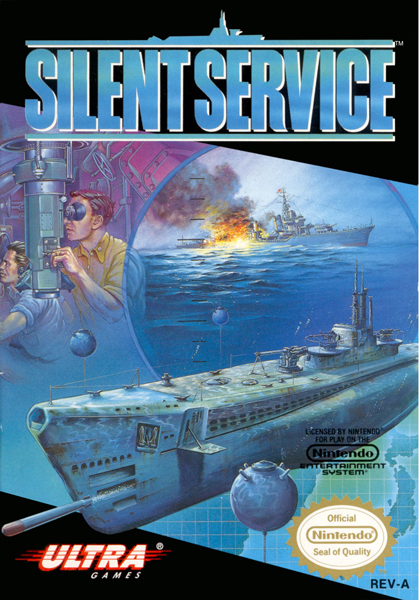
Silent Service
System: NES
Release Date: December 1989
Developer: Rare
Publisher: Ultra Games
Genre: Simulation
If you’ve ever wanted to know the feeling of sinking Japanese naval convoys during World War 2, then Silent Service is the game for you! You are the captain of a U.S. submarine in the Pacific Theater. It’s up to you to help turn the tide of the war with your fellow seamen and not get swallowed up.
Controlling this submarine requires two NES controllers; more sophisticated than a modern day submersible vehicle. There are three different modes of play: Torpedo/Gun Practice, Convoy Actions, and War Patrols. Control of your submarine is on the screen and consists of setting your speed from 0 through 4. 0 is your go to for silent running. Then there are some arrows. The up arrow surfaces. The down arrow dives. The left and right arrows turn you. The gun icon shoots guns on the surface, and the torpedo icon shoots torpedoes if they are loaded. You can set up or down periscope, as well. The F increases the speed of the simulation and the N sets it back to normal.
Practice is just what it says, you are put up against four unmoving targets. There are several levels of map from the entire theater to the attack plot map on a small scale. Your best friend is the Torpedo Data Computer. While looking out the binoculars or the periscope, you can practice playing with the deflection of the surface guns, which needs to be set if ships are running toward or away from you. Aiming at enemy boats will automatically take into account its speed and direction so you don’t undershoot it.
Convoy Actions are a shorter scenario that tasks you with sinking as much tonnage as you can with your targets starting nearby. There are several options that can be set to change the difficulty of the scenario. Depending on the time of day (or night), should inform if you want to surface to attack or stay at periscope depth. You can blast those fools to Davy Jones’ locker if you can catch them off guard. But hopefully, you’ve targeted the Destroyer escort first, or they will make a bee line for your position. This is when you need to dive in order to escape or regroup for a counter attack. Sitting there listening to engine noises wax and wane is a bit unnerving. You can try to trick them by releasing debris to make them think you’re dead.
The final game mode is the grand theater of War Patrols. You start from an allied port and your goal is to blow holes in as many Japanese ships as possible. You start on the South Pacific map and directly move your sub around the map until you encounter a patrol. You need to take them out while taking as little damage as you can, yourself. Once your adversaries start their counter attack, you may find that some of your systems are shut down. If you lose your sonar, you can’t see enemies on the map screen. If your surface guns are hit, you lose those attack options. If you start taking on water, you sink whether you’re diving or not. If you hit the ocean floor, it’s game over.
Graphics: 2.0
You can tell what everything is supposed to be and the graphics aren’t a hindrance.
Sound: 2.0
Sounds are an integral part to gameplay, whether it’s enemy engines or different alerts.
Gameplay: 2.0
The controls are surprisingly easy to get attuned to. I feel like I needed a full crew, though.
Difficulty: 2.5
What I played wasn’t too difficult, but you can make each scenario easier or harder when you start.
Fun Factor: 2.0
I can see a submarine simulation putting people to sleep, but if you’re into the genre, you’ll like playing this.
Overall Grade: 2.1
Silent Service earns a C. It’s safer to roam the South Pacific during WW2 than check out the Titanic.
